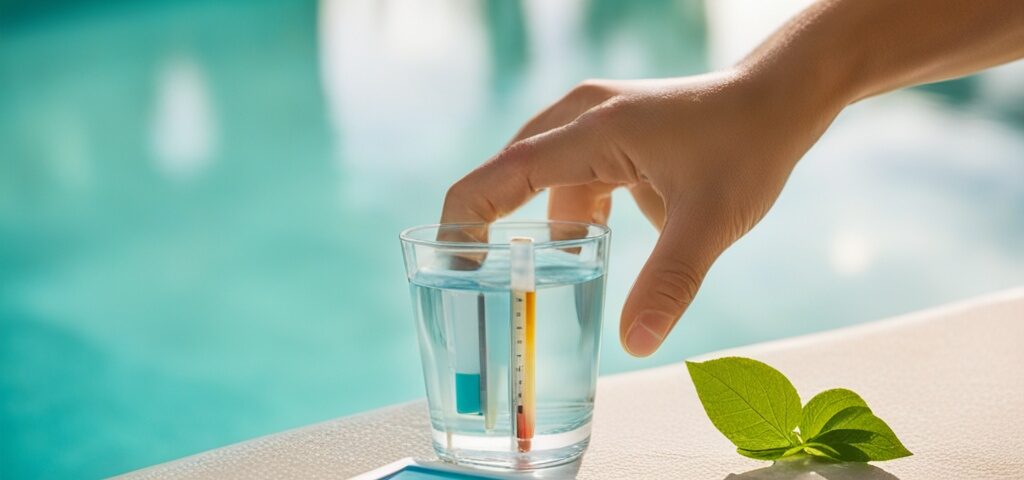Unlock Crystal Clarity: Mastering Pool Water Testing

5 Lightning-Fast Ways to Revive a Green Pool!
May 15, 2025
5 Costly Pool Construction Blunders You Must Dodge
May 16, 2025Understanding the Importance of Testing Pool Water
Maintaining a pristine swimming pool requires vigilance and a commitment to regular testing of pool water. The significance of this practice cannot be overstated; it ensures not only optimal water quality but also the safety of those who revel in the refreshment of swimming. When pool water is not tested consistently, numerous complications can arise, potentially leading to an unsafe aquatic environment, which in turn may deter swimmers and pose health risks.
Water Quality and Swimmer Safety
Testing pool water serves as a diagnostic tool for monitoring its quality. Factors such as temperature, pH levels, and chemical balances can fluctuate due to environmental conditions, usage, and even bather load. When parameters are not within recommended ranges, the water can become a breeding ground for harmful microorganisms, leading to illness. A well-tested pool, in contrast, offers a safe haven for relaxation and recreation, free from the worry of irritation or infection.
Key Factors Affecting Pool Water Quality
Several critical components play a pivotal role in maintaining the equilibrium of pool water. pH levels are paramount; they determine the acidity or alkalinity of the water, with ideal levels ranging from 7.2 to 7.8. If these levels skew too far in either direction, it can lead to issues such as skin irritation for swimmers and corrosion of pool equipment. Furthermore, chlorine levels are crucial for sanitizing the water, keeping it clear of bacteria and other pathogens. The ideal chlorine concentration should be between 1.0 and 3.0 parts per million (ppm), which not only protects swimmers but also ensures a crystal-clear appearance.
| Parameter | Ideal Range | Effects of Imbalance |
|---|---|---|
| pH Levels | 7.2 – 7.8 | Skin irritation, equipment corrosion |
| Chlorine Levels | 1.0 – 3.0 ppm | Bacterial growth, cloudy water |
| Alkalinity | 80 – 120 ppm | pH fluctuations, water clarity issues |
Alkalinity’s Role in Pool Chemistry
Equally important is total alkalinity, which acts as a buffer against rapid pH changes. Ideal alkalinity levels should hover between 80 to 120 ppm. Insufficient alkalinity can lead to unstable pH levels, creating a challenging environment for maintaining overall water quality. Conversely, excessive alkalinity can cause cloudy water or scaling on pool surfaces. This delicate balance underscores the importance of meticulous testing and adjustment based on the readings obtained.
Environmental Influences on Pool Water
Environmental factors also contribute to shifts in pool water quality. Rain, debris, and organic matter can introduce contaminants that disrupt the chemical balance. For example, heavy rainfall can dilute chemical concentrations, prompting the necessity for testing shortly after a storm. Additionally, seasonal changes may require more frequent tests, as increased temperature and sun exposure can accelerate evaporation and chemical reactions. Recognizing these influences is essential for maintaining a consistently enjoyable swimming experience.
Conclusion: The Path to Pristine Waters
In summary, understanding the vital aspects of testing pool water is essential for any pool owner or enthusiast. Consistent monitoring of pH levels, chlorine levels, and alkalinity not only ensures that the water remains clean and safe but also promotes a pleasant swimming environment. A proactive approach to water quality is the linchpin of successful pool maintenance, inviting swimmers to dive into crystal-clear waters with confidence and peace of mind.
Different Methods of Testing Pool Water
Ensuring the health and clarity of your swimming pool requires regular water testing, a necessary process that can be accomplished through various methods. Understanding the different testing techniques available can help pool owners make informed decisions, tailoring their approach to both need and preference. The primary methods include test kits, test strips, and digital testers, each presenting distinct advantages and disadvantages.
Test Kits
Test kits are a more traditional method for testing pool water, typically involving a combination of reagents and color-matching charts. Most comprehensive test kits will analyze several key chemicals, including pH, chlorine, alkalinity, and stabilizer levels.
Pros: One of the primary advantages of test kits is their accuracy. They often provide precise measurements of various chemical levels, which is crucial for maintaining balanced water quality. Additionally, they can be cost-effective in the long run, as they allow repeated use before needing replenishment.
Cons: However, a downside is that they require a certain level of skill for accurate usage and interpretation of results. Furthermore, the process can be more time-consuming than other methods, potentially deterring some owners from regular testing.
Test Strips
Test strips present a more user-friendly alternative, involving a simple dip into pool water. After a brief wait, users compare the color change on the strip to a provided chart to evaluate chemical levels.
Pros: The ease of use is a significant benefit; test strips enable quick readings with a minimal learning curve. They are portable and convenient, making them ideal for on-the-go checks without the need for extensive equipment.
Cons: Nonetheless, test strips are often less accurate compared to test kits, primarily because they rely on subjective color interpretation, which can lead to misreading results. Additionally, the accuracy of strips can decline if they are not stored properly or are exposed to moisture.
Digital Testers
Digital testers have gained popularity for their advanced technology and precision. These electronic devices analyze water samples and provide digital readings, often integrating functionalities for various tests in one tool.
Pros: Digital testers are acclaimed for their accuracy and quick results, providing a more straightforward and efficient testing process. Many models also have features such as Bluetooth connectivity or app integration, allowing users to track their water quality over time effortlessly.
Cons: On the contrary, digital testers can be a significant upfront investment, often requiring frequent calibration and battery replacements, which may lead to ongoing costs. Also, they may not be as portable as test strips, limiting their utility to home environments.
| Testing Method | Pros | Cons |
|---|---|---|
| Test Kits | High accuracy, comprehensive testing | Time-consuming, requires skill |
| Test Strips | Quick and easy to use | Less accurate, subjective results |
| Digital Testers | High precision, instant results | Higher initial cost, requires calibration |
Step-by-Step Guide to Testing Pool Water
1. Gather Your Supplies
Before diving into the testing process, ensure you have the appropriate testing supplies at your disposal. Depending on the method chosen, you may need:
- Pool water test kit (colorimetric or digital)
- Clear sample container
- Strips or reagents (for chemical tests)
- pH testing solution
2. Collect a Water Sample
To obtain an accurate reading, timing and technique matter. Use a clean, plastic sample container to collect water from elbow depth (approximately 12 to 18 inches below the surface) away from any return jets or skimmers. This ensures that your sample is representative of the overall pool water chemistry.
3. Test for Key Parameters
Focus on the following critical parameters to gauge your pool’s health:
| Parameter | Ideal Range | Testing Method |
|---|---|---|
| pH Level | 7.2 – 7.8 | pH Test Strips or Reagents |
| Chlorine Level | 1 – 3 ppm | Test Kit or Strips |
| alkalinity | 80 – 120 ppm | Test Kit |
| Calcium Hardness | 200 – 400 ppm | Test Kit |
| Cyanuric Acid | 30 – 50 ppm | Test Kit |
Follow the instructions on your testing method closely for the most reliable results. If you are using colorimetric tests, compare your results promptly to avoid any discrepancies.
4. Analyze the Results
Once you have your readings, compare them against the ideal ranges outlined above. If any parameters fall outside their ideal limits, adjustments must be made to maintain proper pool water chemistry. For example, if the pH is too low, consider adding a pH increaser (sodium carbonate); if chlorine levels are low, you may need to shock the pool with chlorine to restore sanitary conditions.
5. Frequency of Testing
To ensure optimal water quality, testing frequency is paramount. Regular testing should occur:
- At least once a week during swimming season
- Bi-weekly in cool or off-peak seasons
- After heavy rainfall or significant pool usage
Proactive maintenance can prevent various issues such as algae growth, cloudy water, and skin irritations for swimmers, making regular tests essential.
6. Troubleshooting Common Issues
If your testing reveals persistent issues, carry out troubleshooting steps that include:
- Adjusting chemical levels systematically
- Checking and cleaning filtration systems
- Inspecting pool surfaces for potential problems
- Consulting a pool professional if issues persist
Consistency in testing and maintenance will ultimately contribute to a sparkling, enjoyable pool experience.
Interpreting Test Results
Understanding the results of your pool water tests is crucial for maintaining a safe and inviting swimming environment. Each parameter provides insights into the water’s chemical balance, which directly affects swimmer comfort and overall pool health. The primary elements to monitor regularly include pH, chlorine, alkalinity, and others that play essential roles in pool maintenance.
Ideal Ranges for Key Parameters
| Parameter | Ideal Range | Impact of Imbalance |
|---|---|---|
| pH | 7.2 – 7.8 | Low pH: Corrosive to equipment; High pH: Reduces chlorine effectiveness. |
| Free Chlorine | 1.0 – 3.0 ppm | Low Levels: Poor sanitation; High Levels: Skin irritation. |
| Total Alkalinity | 80 – 120 ppm | Low TA: pH fluctuations; High TA: Cloudy water. |
| Calcium Hardness | 200 – 400 ppm | Low Hardness: Corrosion; High Hardness: Scale formation. |
Interpreting Out-of-Range Results
When your test results fall outside the ideal ranges, it’s essential to assess the implications of these deviations. For example, a low pH can lead to corrosive conditions that compromise metal surfaces and pool accessories, while a high pH creates an environment where chlorine is less effective, resulting in potential health hazards such as algae growth. Conversely, drastic fluctuations in free chlorine levels can indicate either insufficient sanitation or the presence of contaminants that could irritate swimmers.
How to Address Imbalances
To rectify low pH levels, consider adding a pH increaser such as sodium carbonate, also known as soda ash. For situations where the pH is excessively high, you can introduce a pH decreaser like muriatic acid or sodium bisulfate. Monitor these levels diligently following any corrective measures, as adjustment of one parameter often affects others. Similarly, if total alkalinity is out of range, you can either add baking soda to raise levels or introduce acid to lower them.
With respect to chlorine levels, an inadequate concentration can often be remedied by returning to regular pool chlorination practices or employing shock treatments to eliminate organic load. When chlorine levels exceed the ideal range, refrain from swimming temporarily and allow the sun and aeration to naturally dissipate excess chlorine. Regular testing and timely intervention will help in sustaining the optimum balance.
Ultimately, the art of interpreting your pool water test results is a continuous undertaking, requiring vigilance and an understanding of the interplay between different chemical factors. Regular monitoring not only prevents significant issues but also ensures that your pool remains an idyllic oasis for relaxation and enjoyment.
Advanced Pool Water Testing Techniques
While basic pool water testing methods are crucial for maintaining optimal water quality, advanced pool water testing techniques can provide a more comprehensive understanding of the health of your swimming pool. Two critical advanced techniques include total dissolved solids (TDS) testing and saturation index calculations. These methods offer deeper insights into the chemical balance of your pool, helping to ensure a safe and enjoyable swimming environment.
Total Dissolved Solids (TDS) Testing
Total dissolved solids refer to the combined concentration of all inorganic and organic substances in the water. Elevated TDS levels can lead to various issues, including reduced effectiveness of sanitizers, cloudy water, and skin irritation for swimmers. Generally, optimal TDS levels in a pool should be below 1500 ppm, while levels above 2000 ppm indicate that water replacement may be necessary.
| Condition | TDS Level (ppm) | Recommended Action |
|---|---|---|
| Good | 0 – 1500 | No action needed |
| Moderate | 1501 – 2000 | Consider water replacement |
| Poor | > 2000 | Immediate water replacement |
Regular TDS testing is particularly necessary for pools in areas with high evaporation rates or those frequently subjected to heavy swimmer loads. When TDS levels begin to climb, it may signify that the water is becoming saturated with impurities, necessitating prompt action to maintain clear and safe water.
Saturation Index Calculations
The saturation index (SI) is a vital metric that indicates whether water is balanced and stable. It includes calculations based on factors like pH, total alkalinity, calcium hardness, and temperature. A saturation index value of zero indicates balanced water, while negative values suggest corrosive conditions, and positive values indicate scaling potential.
Maintaining the saturation index within the range of -0.3 to +0.3 is essential to prevent damage to pool surfaces and equipment. Understanding the elements that influence the SI can help pool owners prevent costly repairs and ensure that their pools remain in pristine condition.
In pools requiring intricate chemistry management—such as indoor pools, saltwater systems, or those exposed to specific environmental conditions—applying these advanced testing techniques can be invaluable. They help pool owners proactively address possible water chemistry issues, ensuring that their aquatic spaces remain an oasis of relaxation and enjoyment.
Common Pool Water Issues and Solutions
Algae Growth
One of the most prevalent challenges pool owners face is algae growth. This unwelcome visitor can turn your crystalline oasis into a green, murky swamp. Algae thrive in warm water, particularly when chlorine levels dip below the ideal range. To combat algae, regular testing for chlorine and pH levels is essential. Aim for a pH level between 7.2 and 7.6 and maintain a chlorine level between 1 to 3 parts per million (ppm).
Solution: Shock Treatment
For existing algae infestations, a shock treatment using a higher dosage of chlorine is recommended. After administering shock, run the pool filter continuously for at least 24 hours and brush the walls and floor to remove any stubborn algae particles, ensuring they get filtered out. Following this, a weekly maintenance program of chlorine and pH testing can prevent a recurrence.
Cloudy Water
Cloudy water can be another formidable issue, which often results from improper filtration, chemical imbalances, or debris accumulation. Pool water clarity is essential not just for aesthetics but also for safety; cloudy water can hide hazardous situations such as sharp objects or swimming pool drains. If the water appears cloudy, it is imperative to test and adjust your alkalinity, pH, and chlorine levels without delay.
Solution: Fine Filtration
Once the cause is determined, a dual approach of flocculants and proper filtration can rectify cloudy water. Flocculants bind small particles, making them easier for your filter to capture. Ensure that your pool filter is adequately maintained and running for a sufficient number of hours per day to enhance water clarity.
Chemical Imbalances
Chemical imbalances in pool water can lead to various problems, including skin irritation, algae growth, and equipment corrosion. Regular testing is crucial, especially during the high-use season. The main parameters to monitor include pH, alkalinity, chlorine, and cyanuric acid levels.
| Parameter | Ideal Range |
|---|---|
| pH | 7.2 – 7.6 |
| Chlorine (Free) | 1 – 3 ppm |
| Alkalinity | 80 – 120 ppm |
| Cyanuric Acid | 30 – 50 ppm |
Solution: Regular Testing and Adjustments
Addressing chemical imbalances involves not only regular testing but also timely adjustments. If pH is too low, adding a pH increaser like sodium carbonate can quickly bring levels back to normal. Conversely, if the pH is too high, a pH reducer is necessary. Continuous monitoring ensures that your pool remains a safe haven, protecting both swimmers and pool equipment.
Maintaining Consistent Pool Water Quality
Ensuring that your pool water remains pristine and inviting requires diligence and a proactive approach to regular testing and maintenance routines. Without consistent oversight, various factors such as debris accumulation, fluctuating pH levels, and chemical imbalances can compromise the overall quality of your pool water, potentially leading to health issues and costly repairs. Therefore, understanding the importance of regular testing serves as the foundation for maintaining an enjoyable swimming environment.
One of the primary facets of maintaining consistent pool water quality is the development of a comprehensive pool water testing schedule. This schedule should ideally incorporate both weekly tests and seasonal adjustments to account for changes in water conditions. Most pool experts recommend testing pH levels, chlorine concentration, alkalinity, and stabilizer levels at least once a week. During peak swimming seasons or after heavy rainfall, increase the frequency to ensure that the water chemistry remains balanced. Adjusting to those changes promptly can mitigate potential issues that might arise from imbalanced water chemistry.
To further streamline your maintenance efforts, consider creating a pool maintenance checklist that you can refer to during each visit. This checklist should include the following key tasks:
| Task | Frequency |
|---|---|
| Test pH levels | Weekly |
| Check chlorine levels | Weekly |
| Inspect alkalinity | Weekly |
| Clean skimmers and filters | Weekly |
| Shock the pool | Monthly |
| Inspect for leaks | Monthly |
Implementing a thoughtful testing and maintenance schedule not only enhances water quality but also extends the lifespan of your pool equipment. Failure to routinely clean filters, for instance, can lead to increased energy costs and reduced efficiency. Moreover, neglecting the chemical balance can necessitate expensive interventions later on. Hence, routine maintenance proves beneficial both financially and for the user experience.
Additionally, it is crucial to engage with the local environmental conditions, as they can significantly influence your pool’s water quality. Factors such as pollen, dust, and debris from trees can cause fluctuations in water chemistry and cleanliness. During autumn months or after significant weather events, pay close attention to how these variables affect your pool, adjusting your maintenance schedule accordingly. Proactive engagement with your pool’s environment allows for tailored solutions that keep swimmers safe and satisfied.
In conclusion, maintaining consistent pool water quality necessitates a commitment to regular testing and a tailored maintenance plan. By establishing a routine that balances testing frequency, environmental considerations, and equipment care, pool owners can enjoy a safe and inviting swimming experience. Embracing this proactive approach ensures that your pool remains a cherished oasis for years to come.
Learn more about Maintenance & Cleaning

Javier Morales is passionate about pool design, maintenance, and outdoor living. With years of hands-on experience, he offers practical tips, creative ideas, and expert insights to help readers make the most of their pool spaces. At Piscina Planet, Javier shares everything from seasonal care guides to the latest trends in pool innovation.




